Cat owners are often vigilant about their pets' health, but sometimes subtle signs can go unnoticed. Giardia, a parasitic infection that can affect cats, presents symptoms that may be mistaken for common gastrointestinal issues. Understanding these signs is crucial for early detection and treatment.
By being aware of the subtle indicators that your cat may be harboring this parasite, you can take proactive steps to safeguard not only your feline companion's health but also potentially your own.
Key Takeaways
- Giardia in cats can be asymptomatic, but watch for diarrhea, lethargy, and poor coat condition.
- Treatment involves anti-parasitic medications like metronidazole and fenbendazole for effective clearance.
- Prevention includes maintaining cleanliness, especially with litter boxes, to reduce the risk of infection.
- Take precautions post-treatment to prevent reinfection, as Giardia is zoonotic and can spread to humans.
Understanding Giardia Parasitic Infection in Cats
What are the key aspects of Giardia parasitic infection in cats that pet owners should be aware of?
Giardia duodenalis, a small parasite, infects cats through contaminated items like water and litter. Kittens in unclean environments or near water sources are at higher risk.
Infected cats shed the parasite through cysts in their feces, contributing to transmission. While many cats show no symptoms, clinical giardiasis can lead to diarrhea, lethargy, gas, and abdominal discomfort.
Treatment involves anti-parasitic medications like metronidazole and fenbendazole to clear the infection.
Preventing Giardia involves maintaining cleanliness, especially in litter boxes, and monitoring outdoor cats to prevent contamination. Pet owners should be vigilant about potential cross-infection risks, as Giardia is zoonotic but direct transmission between pets and humans is uncommon.
Shedding of Giardia Cysts in Feces
The shedding of Giardia cysts in feces by infected cats is a significant factor in the transmission of the parasite to other animals and potentially to humans. When a cat is infected with Giardia, the parasite reproduces in the small intestine and forms cysts that are passed out in the feces.
These hardy cysts can survive in the environment for extended periods, contaminating water sources, soil, and surfaces. This fecal-oral route of transmission is a key way the infection spreads, especially in multi-pet households or communal living spaces.
Proper hygiene practices, such as promptly cleaning and disposing of feces and maintaining clean litter boxes, are essential in preventing the further spread of Giardia.
Transmission via Contaminated Items
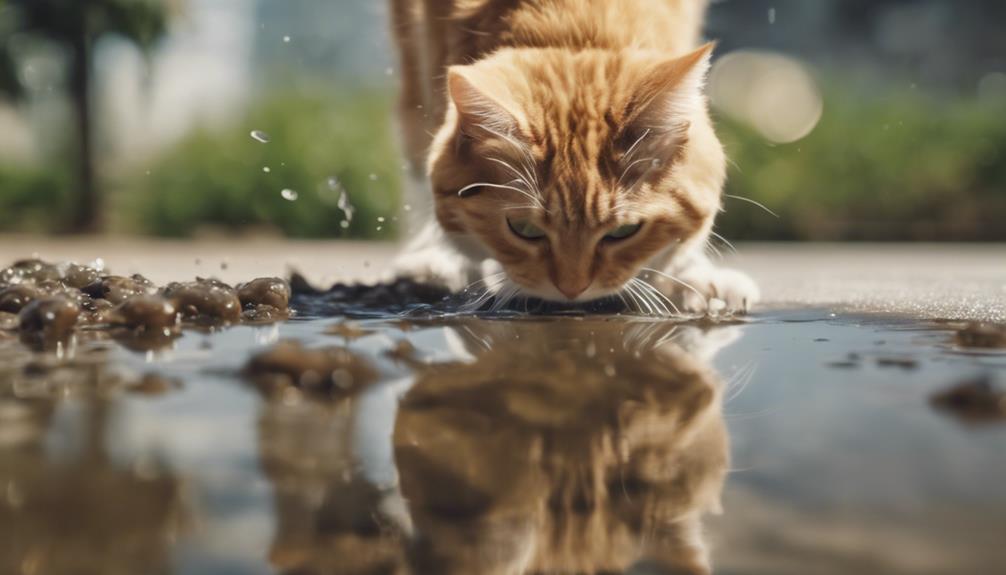
Transmission of Giardia via contaminated items is a common pathway for the spread of the parasite among cats and potentially to other animals and humans. The following points highlight the importance of understanding this mode of transmission:
- Litter Boxes: Regularly cleaning and disinfecting litter boxes is crucial to prevent the spread of Giardia.
- Water Sources: Cats drinking from contaminated water sources can easily become infected, emphasizing the need for clean water access.
- Shared Items: Avoid sharing items like bedding or toys between infected and uninfected cats to minimize the risk of transmission.
Risks for Kittens and Outdoor Cats
Risks associated with Giardia parasitic infection are notably higher for kittens raised in unclean environments and outdoor cats frequenting water sources. Kittens, especially those in overcrowded or unsanitary conditions, have weaker immune systems, making them more susceptible to Giardia.
Outdoor cats that come into contact with contaminated water sources, such as ponds or streams, are also at an increased risk of infection. These environments provide ideal conditions for the parasite to thrive and spread.
It is crucial for cat owners to be vigilant in monitoring their kittens' living conditions and outdoor cats' activities to minimize the risk of Giardia infection. Regular cleaning and proper hygiene practices can help reduce the chances of exposure to this parasitic infection.
Asymptomatic Giardia Infections
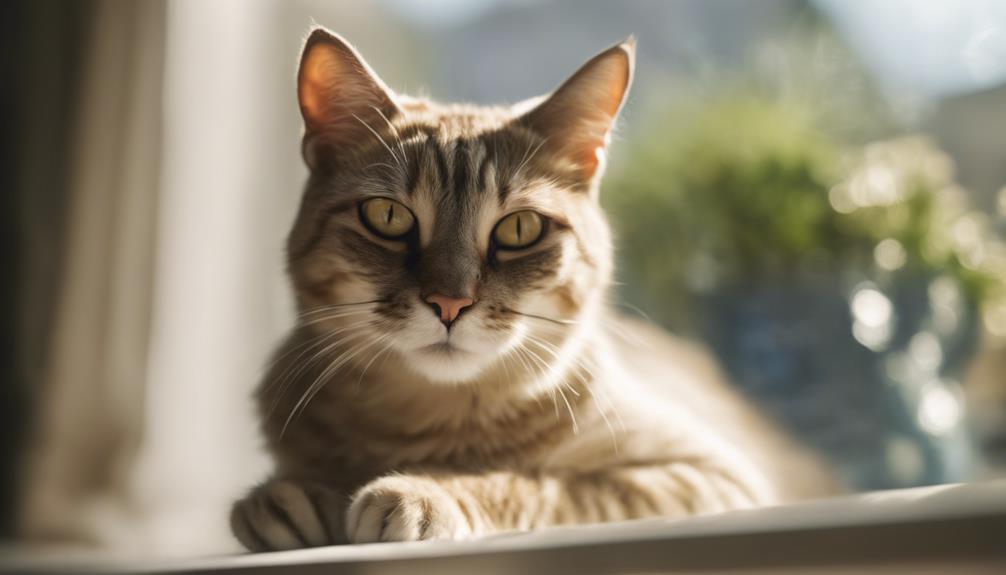
In cases of Giardia parasitic infection in cats, a significant proportion of individuals exhibit no apparent symptoms, a condition known as asymptomatic giardiasis. This lack of visible signs can make it challenging for cat owners to detect the infection. Understanding asymptomatic giardiasis is crucial for ensuring the health and well-being of your feline companion.
- Silent Carrier: Cats with asymptomatic giardiasis can still shed the parasite in their feces, potentially contaminating their environment.
- Diagnostic Dilemma: The absence of symptoms complicates the diagnosis of Giardia in cats, requiring specific tests for accurate identification.
- Importance of Monitoring: Regular veterinary check-ups and fecal examinations are essential for detecting asymptomatic infections early on and preventing the spread of Giardia.
Clinical Signs of Giardiasis in Cats
When considering the clinical presentation of Giardiasis in cats, the absence of noticeable symptoms can complicate the timely identification and management of this parasitic infection. Cats infected with Giardia may not always display overt signs of illness, making it challenging for pet owners to detect the presence of the parasite.
However, when clinical signs do manifest, they commonly include diarrhea, foul-smelling stool, lethargy, gas, poor coat condition, and abdominal discomfort. In severe cases, symptoms may escalate to include nausea, vomiting, weight loss, and overall decline in health, particularly in kittens and older cats with weakened immune systems.
Understanding these potential indicators of Giardia infection is crucial for prompt diagnosis and effective treatment.
Diarrhea and Foul-Smelling Stool

The presence of diarrhea and foul-smelling stool in cats infected with Giardia can serve as key clinical indicators of the parasitic infection. These symptoms may manifest as follows:
- Increased Frequency: Cats may experience more frequent bowel movements, often loose or watery in consistency.
- Unpleasant Odor: Stool may emit a particularly strong and unpleasant smell, indicative of the presence of Giardia.
- Accompanying Dehydration: Diarrhea can lead to dehydration in cats, emphasizing the importance of timely intervention and treatment.
Monitoring changes in your cat's stool consistency and odor can provide valuable insights into their health status and the potential presence of Giardia infection.
Lethargy and Gas Symptoms
Lethargy and excessive gas production are additional clinical manifestations that can accompany diarrhea and foul-smelling stool in cats infected with Giardia parasites. Cats with Giardia may exhibit signs of general weakness, lack of energy, and increased flatulence. These symptoms can contribute to the overall discomfort experienced by the infected feline. If you notice your cat displaying these signs along with other symptoms mentioned earlier, it is crucial to consult a veterinarian for proper diagnosis and treatment. Below is a table summarizing the common signs associated with Giardia infection in cats:
| Symptom | Description |
|---|---|
| Diarrhea | Loose or watery stool |
| Foul-smelling stool | Unpleasant odor in feces |
| Lethargy | Lack of energy and enthusiasm |
| Gas | Increased flatulence |
Poor Coat Condition and Discomfort
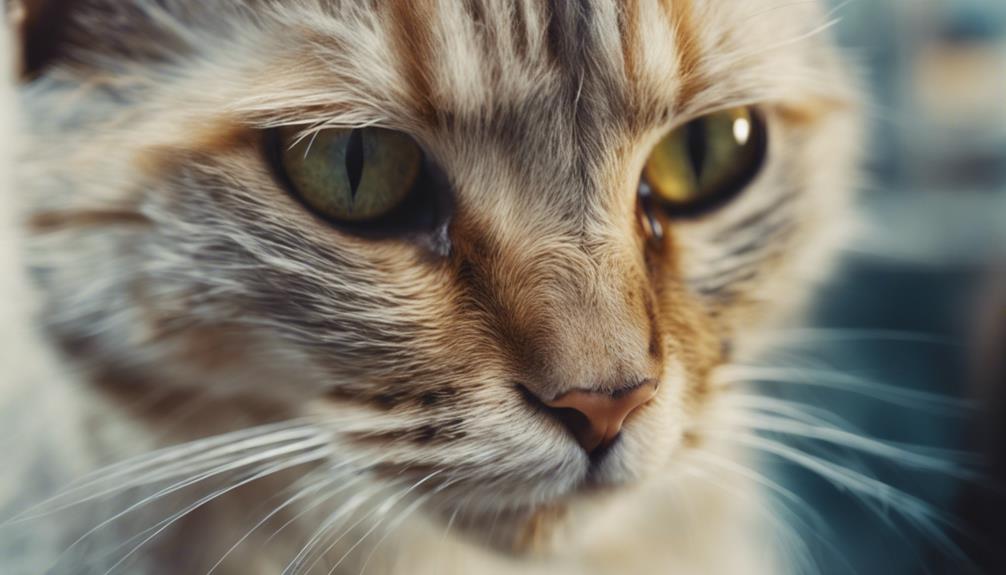
A common manifestation of Giardia parasitic infection in cats includes evident signs of discomfort and a decline in the quality of their coat. Giardia can cause cats to experience various distressing symptoms, impacting their overall well-being.
- Constant Scratching: Cats may excessively scratch themselves due to discomfort caused by Giardia infection.
- Dull and Matted Fur: The cat's coat may appear lackluster and unkempt, indicating underlying health issues.
- Restlessness and Irritability: Infected cats may exhibit restlessness and increased irritability, reflecting their discomfort and unease.
These signs highlight the importance of promptly addressing Giardia infections to alleviate the cat's distress and restore their coat's health.
Severe Cases and Complications
In advanced stages of Giardia parasitic infection in cats, severe cases can present with a range of complications affecting their overall health and well-being. These complications may include dehydration, malnutrition, and electrolyte imbalances due to persistent diarrhea and vomiting. Prompt veterinary intervention is crucial in managing these severe cases to prevent further deterioration of the cat's health. Below is a table summarizing the potential complications seen in severe Giardia infections:
| Complication | Description | Management |
|---|---|---|
| Dehydration | Loss of fluids leading to electrolyte imbalances | Fluid therapy may be necessary |
| Malnutrition | Lack of essential nutrients due to poor absorption | Nutritional support and dietary adjustments |
| Electrolyte Imbalances | Disruption in crucial electrolyte levels | Electrolyte supplementation and monitoring |
Early detection and appropriate treatment are key in addressing these complications and improving the cat's prognosis.
Treatment Challenges and Diagnosis
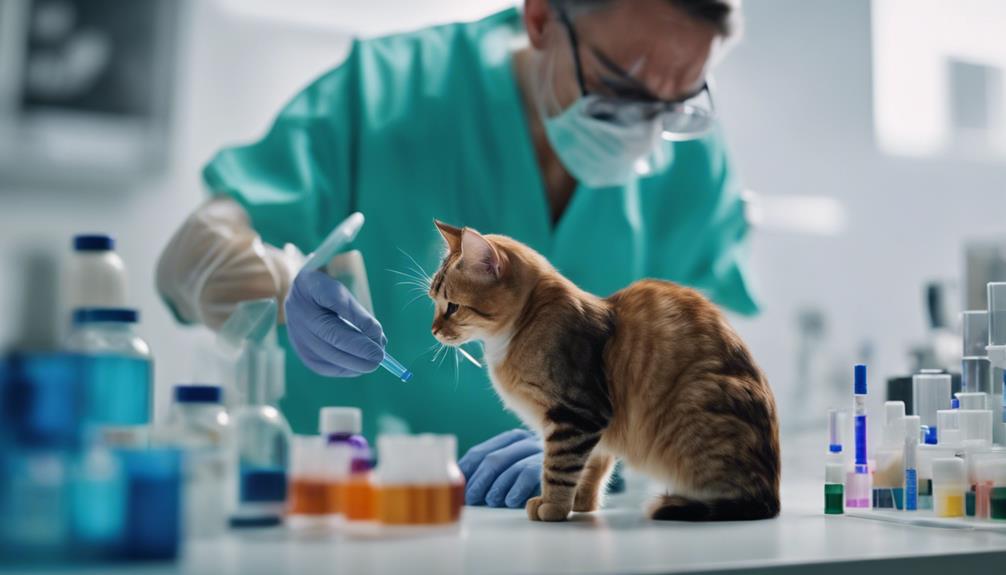
Challenges in diagnosing and treating Giardia infections in cats can stem from the parasite's ability to intermittently shed cysts, complicating accurate detection and necessitating targeted therapeutic approaches. When faced with Giardia infections in cats, veterinarians and cat owners may encounter the following obstacles:
- Intermittent Shedding: The sporadic release of cysts makes it challenging to detect Giardia during routine fecal examinations.
- Resistance to Medications: Some Giardia strains may exhibit resistance to commonly prescribed anti-parasitic medications.
- Environmental Contamination: Repeated exposure to contaminated environments can lead to reinfection, requiring stringent hygiene measures post-treatment.
Navigating these challenges demands a thorough understanding of the parasite's behavior and a tailored treatment approach for affected felines.
Anti-Parasitic Medications for Giardia
When addressing Giardia infections in cats, the selection of appropriate anti-parasitic medications plays a crucial role in effectively managing the parasitic infection. Commonly prescribed medications for treating Giardia in cats include:
| Medication | Dosage |
|---|---|
| Metronidazole | Varies based on weight and severity of infection |
| Fenbendazole | Typically administered once a day for multiple days |
Metronidazole and fenbendazole are among the primary choices to combat Giardia. The dosage of these medications is usually determined by the cat's weight and the extent of the infection. Adhering to the prescribed dosage and duration is essential for successful treatment outcomes. Always consult a veterinarian before administering any anti-parasitic medications to your cat.
Clearing the Giardia Infection
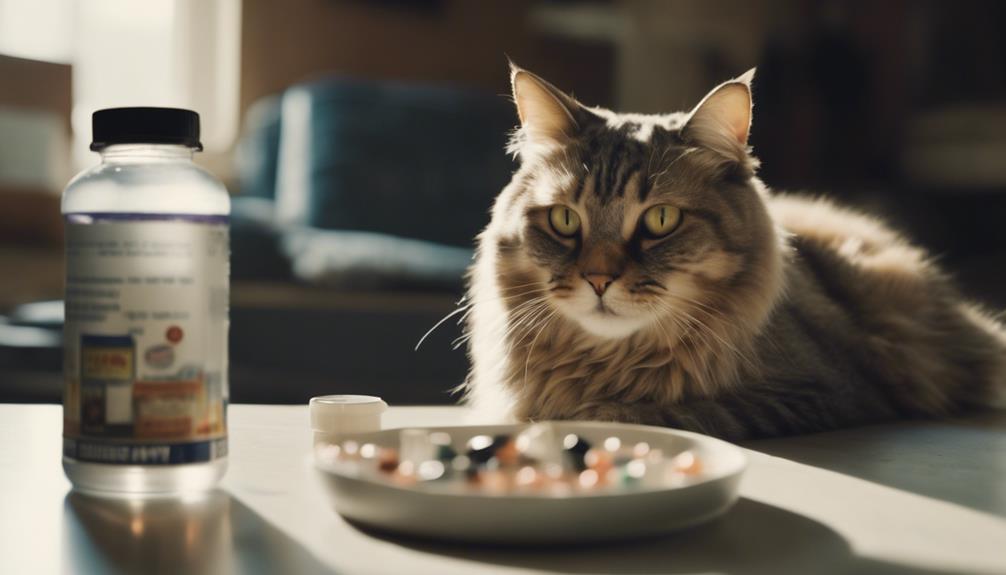
Effective treatment for clearing a Giardia infection in cats involves the administration of prescribed anti-parasitic medications tailored to the individual cat's weight and the severity of the infection. It is essential to follow the veterinarian's instructions carefully to ensure successful eradication of the parasite.
To enhance the understanding of clearing a Giardia infection, consider the following points:
- Consistency: Administer medications regularly as prescribed to maintain therapeutic levels in the cat's system.
- Environment: Clean and disinfect the cat's living area to prevent recontamination.
- Monitoring: Keep a close eye on the cat's symptoms and consult the veterinarian if any concerns arise during the treatment process.
Importance of Post-Treatment Cleanliness
To ensure the successful eradication of Giardia parasites in cats, maintaining a meticulously clean environment post-treatment is imperative. After treating your cat for Giardia, it is crucial to focus on cleanliness to prevent reinfection and protect other pets or family members. Below is a table outlining key areas to prioritize when cleaning post-treatment:
| Area to Clean Post-Treatment | Cleaning Instructions | Frequency |
|---|---|---|
| Cat's Fur | Gently groom with a clean brush to remove any cysts | Daily |
| Litter Box | Scoop waste daily, disinfect the box weekly | Daily scooping, weekly disinfection |
| Home Environment | Thoroughly clean floors, surfaces, and cat bedding | Weekly deep cleaning |
Preventative Measures for Giardia
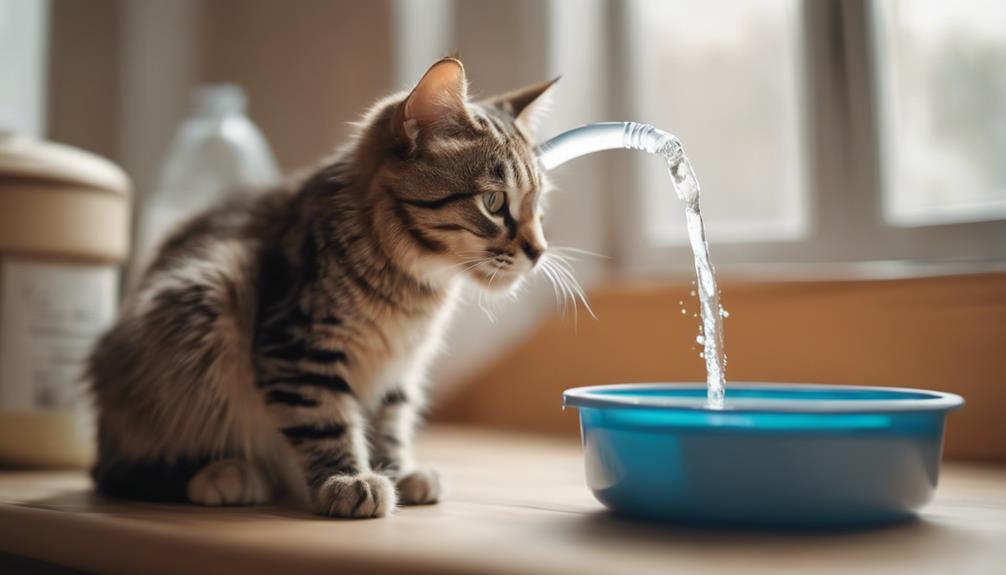
Implementing strict hygiene protocols is essential in minimizing the risk of Giardia infection in cats. To prevent this parasitic infection effectively, consider the following measures:
- Regular Cleaning: Maintain a clean environment by frequently disinfecting the litter box and surrounding areas to reduce the chances of contamination.
- Monitoring Water Sources: Keep outdoor cats away from potentially contaminated water sources to prevent ingestion of Giardia cysts.
- Post-Treatment Vigilance: After treatment, continue monitoring your cat for any signs of reinfection and take necessary precautions to avoid recurrence.
Frequently Asked Questions
Can Cats With Giardia Infect Other Animals in the Household?
While cats with giardia can potentially infect other animals in the household through fecal-oral transmission, the risk is generally low. To prevent cross-infection, ensure infected cats' feces are promptly removed and practice good hygiene measures throughout the home.
Is There a Specific Test to Confirm if a Cat Is Free of Giardia After Treatment?
After treatment for Giardia in cats, confirm eradication with a fecal test. Ensure a negative result before considering the cat free of the parasite. Regular veterinary follow-ups post-treatment are advisable to monitor for any signs of reinfection.
Are There Any Natural Remedies or Supplements That Can Help in Managing Giardia in Cats?
While natural remedies may be appealing, managing Giardia in cats requires vet-prescribed treatments like metronidazole or fenbendazole for effective parasite clearance. Prioritize hygiene post-treatment to prevent reinfection. Consult your vet for the best course of action.
Can Indoor Cats Without Access to Contaminated Water Sources Still Get Giardia?
Indoor cats without access to contaminated water sources can still get Giardia through contact with infected feces or contaminated items like shared litter boxes. Regular monitoring, cleanliness, and preventive measures are essential.
Are There Any Long-Term Effects on a Cat's Health if Giardia Is Left Untreated?
Untreated Giardia in cats can lead to chronic gastrointestinal issues, malnutrition, and weight loss. Prolonged infection may weaken the immune system, affecting the cat's overall health. Timely diagnosis and treatment are essential to prevent long-term complications.
What Are the Similarities and Differences between Giardia and Coccidia Infections in Cats?
Giardia and coccidia are both parasites that can infect cats. The similarities between the two include causing gastrointestinal issues and being spread through feces. However, the signs and symptoms of coccidia specifically include diarrhea, dehydration, and weight loss, while Giardia can also cause vomiting and lethargy.
Conclusion
In conclusion, recognizing the signs and symptoms of Giardia in cats is crucial for timely diagnosis and treatment. Understanding the shedding of Giardia cysts, transmission routes, and risks associated with the infection can help cat owners safeguard their pets' health. By following prescribed anti-parasitic medications and maintaining strict hygiene practices post-treatment, the Giardia infection can be effectively cleared.
Implementing preventative measures to prevent cross-infection between pets and humans is essential for overall well-being.




